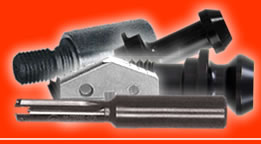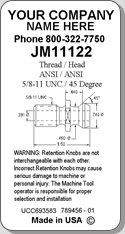J&M Machine | 1234 High Street | Fairport Harbor, Ohio 44077 | 440.357.1234



| HIGH-TORQUE RETENTION KNOBS | |
| RETENTION KNOB SOCKETS | |
| SPADE DRILL TIPS | |
| Speeds & Feeds | |
| SPADE DRILL HOLDERS | |
| IDENTIFY or ORDER CUSTOM RETENTION KNOBS |
||
| IDENTIFY or ORDER CUSTOM SPADE DRILL TIPS |
||
| IDENTIFY or ORDER CUSTOM SPADE DRILL TOOL HOLDERS |
||

When buying from your local
distributor, always look for this label
and set your course for quality!
RETENTION KNOB SAFETY!
Retention knobs and pull studs are not intended to last forever. Your Safety Program must include inspections. Pull studs must be visually inspected for damage and checked for tightness every time the tool in the holder is changed.
Always inspect a new retention knob or pull stud to make sure that it hasn't been damaged in transit.
Before installing a new retention knob or pull stud in a tool holder, clean both items with solvent and blow them off with an air hose. Inspect both items to make sure that there are no nicks or scratches on joining surfaces.
Always tighten retention knobs and pull studs with a torque wrench. The force required is very hard to judge without a torque wrench. A retention knob or pull stud that is too loose or too tight is dangerous.
Retention knobs or pull studs are designed to be the weakest link between the spindle and the tool holder. For this reason they are not intended to last forever. Monitor their condition and be sure to include retention knobs and pull studs in your Safety Program.
Keep A Maintenance Schedule
Every 2-3 years, depending on use, knobs should be removed from the holder and magnetic particle inspected. Any retention knobs or pull studs showing indications of cracking must be discarded.
If your machine is in a crash, or releases a tool prematurely, this is an indication that either the Retention Knob fingers, finger guide, belleville washers in the spindle or the Retention Knob is damaged.
The machine tool should not be used until inspected by Maintenance Personnel. In this case, all the retention knobs in the machine should be checked for cracks or damage immediately.
Inspecting Retention Knobs and Pull Studs
Gripper fingers make burnish marks under the head of the retention knobs. When examining retention knobs, pay close attention to the micro-inch finish of the gripper fingers. All the marks made by the gripper fingers should be uniform. This indicates that the gripper fingers are in good condition. If one mark is different than the rest, this indicates that one gripper finger is damaged or broken.
Look for linear indications, cracks or seams. Retention knobs and pull studs are held in the machine by gripper fingers that are attached to the draw bar. Pressure is applied to the draw bar by the belleville washers. This combination holds the tool in place in the machine. This pressure is about 2,800 lbs. in a 40-taper machine.
The roughing tries to pull the tool out of the spindle. So, at times, the pull on a retention knob is greater than 2,800 lbs. Tool marks or any imperfections in the knob's finish will, in time, be where the tool begins to crack.
Normally a line will start to form around the stud in the direction that the machinoing marks are. The longer that pressure is applied to the retention knob, the deeper the lines become. If the operator inspects the finish of the retention knob every time he changes tools in the machine, he can be instramental in replacing the stud before the pull stud fails.
After reading this, I am sure that you can see that preventive maintenance is possibly the best idea of all.
John Stoneback, President
J&M Machine, Inc.
Retention knobs and pull studs are not intended to last forever. Your Safety Program must include inspections. Pull studs must be visually inspected for damage and checked for tightness every time the tool in the holder is changed.
Always inspect a new retention knob or pull stud to make sure that it hasn't been damaged in transit.
Before installing a new retention knob or pull stud in a tool holder, clean both items with solvent and blow them off with an air hose. Inspect both items to make sure that there are no nicks or scratches on joining surfaces.
Always tighten retention knobs and pull studs with a torque wrench. The force required is very hard to judge without a torque wrench. A retention knob or pull stud that is too loose or too tight is dangerous.
Retention knobs or pull studs are designed to be the weakest link between the spindle and the tool holder. For this reason they are not intended to last forever. Monitor their condition and be sure to include retention knobs and pull studs in your Safety Program.
Keep A Maintenance Schedule
Every 2-3 years, depending on use, knobs should be removed from the holder and magnetic particle inspected. Any retention knobs or pull studs showing indications of cracking must be discarded.
If your machine is in a crash, or releases a tool prematurely, this is an indication that either the Retention Knob fingers, finger guide, belleville washers in the spindle or the Retention Knob is damaged.
The machine tool should not be used until inspected by Maintenance Personnel. In this case, all the retention knobs in the machine should be checked for cracks or damage immediately.
Inspecting Retention Knobs and Pull Studs
Gripper fingers make burnish marks under the head of the retention knobs. When examining retention knobs, pay close attention to the micro-inch finish of the gripper fingers. All the marks made by the gripper fingers should be uniform. This indicates that the gripper fingers are in good condition. If one mark is different than the rest, this indicates that one gripper finger is damaged or broken.
Look for linear indications, cracks or seams. Retention knobs and pull studs are held in the machine by gripper fingers that are attached to the draw bar. Pressure is applied to the draw bar by the belleville washers. This combination holds the tool in place in the machine. This pressure is about 2,800 lbs. in a 40-taper machine.
The roughing tries to pull the tool out of the spindle. So, at times, the pull on a retention knob is greater than 2,800 lbs. Tool marks or any imperfections in the knob's finish will, in time, be where the tool begins to crack.
Normally a line will start to form around the stud in the direction that the machinoing marks are. The longer that pressure is applied to the retention knob, the deeper the lines become. If the operator inspects the finish of the retention knob every time he changes tools in the machine, he can be instramental in replacing the stud before the pull stud fails.
After reading this, I am sure that you can see that preventive maintenance is possibly the best idea of all.
John Stoneback, President
J&M Machine, Inc.




